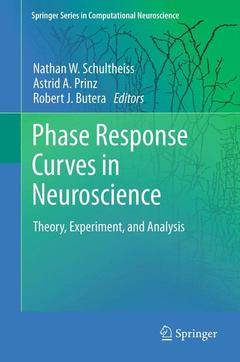Phase Response Curves in Neuroscience, 2012 Theory, Experiment, and Analysis Springer Series in Computational Neuroscience Series, Vol. 6

Preface.- Part 1; Foundations of Phase Response Analysis.- Introduction to Part 1.- Chapter 1. The theory of weakly coupled oscillators.- Chapter 2. Phase resetting neural oscillators: Topological theory versus the real world.- Chapter 3. A theoretical framework for the dynamics of multiple intrinsic oscillators in single neurons.- Chapter 4. History of the application of the phase resetting curve to neurons coupled in a pulsatile manner.- Part 2; Estimation of Phase Response Curves.- Introduction to Part 2.- Chapter 5. Experimentally estimating phase response curves of neurons: Theoretical and practical issues.- Chapter 6. A geometric approach to phase resetting estimation based on mapping temporal to geometric phase.- Chapter 7. PRC estimation with varying width intervals.- Chapter 8. Bayesian approach to estimating phase response curves.- Part 3; Cellular Mechanisms of Neuronal Phase Response Properties.- Introduction to Part 3.- Chapter 9. Phase response curves to measure ion channel effects on neurons.- Chapter 10. Cellular mechanisms underlying spike-time reliability and stochastic synchronization: Insights and predictions from the phase-response curve.- Chapter 11. Recovery of stimuli encoded with a Hodgkin-Huxley neuron using conditional PRCs.- Chapter 12. Cholinergic neuromodulation controls PRC type in cortical pyramidal neurons.- Chapter 13. Continuum of type I somatic to type II dendritic PRCs; Simulatingin vitro and in vivo phase response properties of a morphologically reconstructed Globus Pallidus neuron model.- Part 4; Prediction of Network Activity with Phase Response Curves.- Introduction to Part4.- Chapter 14. Understanding activity in electrically coupled networks using PRCs and the theory of weakly coupled oscillators.- Chapter 15. The role of intrinsic cell properties in synchrony of neurons interacting via electrical synapses.- Chapter 16. A PRC description of how inhibitory feedback promotes oscillation stability.-Chapter 17. Existence and stability criteria for phase locked modes in ring networks using phase resetting curves and spike time resetting curves.- Chapter 18. Phase resetting curve analysis of global synchrony, the splay mode and clustering in N neuron all to all pulse-coupled networks.- Chapter 19. Effects of the frequency dependence of phase response curves on network synchronization.- Chapter 20. Phase-resetting analysis of gamma-frequency synchronization of cortical fast-spiking interneurons using synaptic-like conductance injection.
Date de parution : 03-2014
Ouvrage de 518 p.
15.5x23.5 cm
Date de parution : 12-2011
Ouvrage de 518 p.
15.5x23.5 cm



